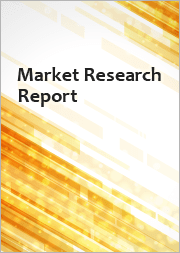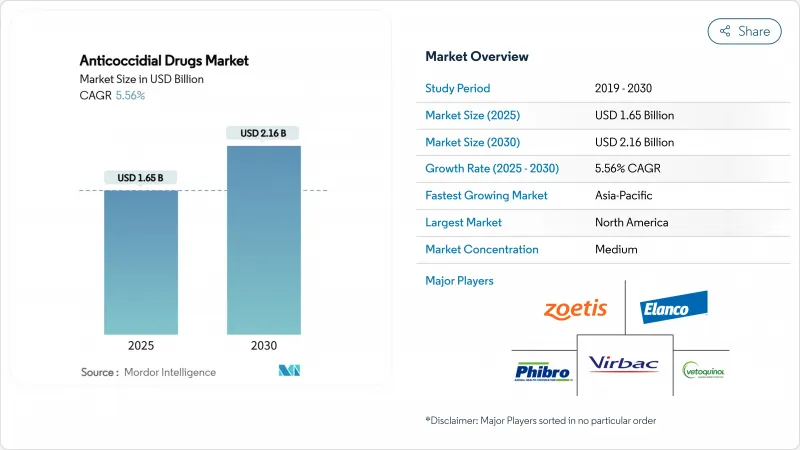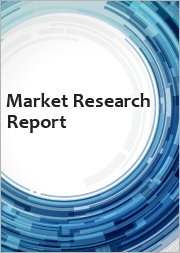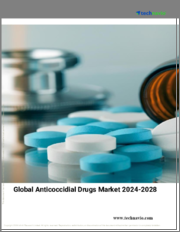
|
시장보고서
상품코드
1852008
항콕시듐제 : 시장 점유율 분석, 산업 동향, 통계, 성장 예측(2025-2030년)Anticoccidial Drugs - Market Share Analysis, Industry Trends & Statistics, Growth Forecasts (2025 - 2030) |
||||||
항콕시듐제 시장 규모는 2025년에 16억 5,000만 달러에 이르고, CAGR 5.56%를 나타낼 전망이며, 2030년에는 21억 6,000만 달러로 확대될 것으로 예측됩니다.

합리적인 가격의 동물성 단백질에 대한 세계적인 수요 증가, 바이오 보안 요건의 엄격화 및 예방 위생 프로토콜의 고도화로 인해 항콕시듐증 대책은 상업 생산자의 가장 중요한 과제가 되고 있습니다. 북미가 선두 자리를 유지하고 있는 이유는 자본력 있는 생산자가 로테이션 프로그램을 일상적으로 실시하고 다른 지역에 앞서 새로운 제제를 채용하고 있기 때문입니다. 규제 당국이 항균성 사료 첨가물을 엄격히 점검하는 동안, 식물성 및 식물성 대체품이 지지를 모으고 디지털 주문 채널은 수의사와 생산자뿐만 아니라 제품에 대한 액세스를 넓히고 있습니다. 경쟁의 심각성은 중간 정도이며, 한 줌의 다각적인 동물 건강 기업이 제조, 유통, 기술 서비스의 통합 능력을 활용하여 점유율을 지키고 있지만, 소규모 혁신 기업는 약제 내성 증가를 완화하는 무잔사 요법이나 병용 요법에 여지를 발견하고 있습니다.
세계의 항콕시듐제 시장 동향과 인사이트
가금류와 가축에서 콕시듐증의 유병률 상승
최근 감시에 따르면 한국의 육계 농장에서는 감염률이 75%를 넘고 있으며, 6가지 주요 약물 클래스에 내성을 가진 야외 분리주가 확인되고 있습니다. 케이지 없이 사육하거나 풀어 놓는 사육으로의 전환은 조류가 환경의 오시스트 부하에 많이 발생하기 때문에 병원체에 대한 노출을 증가시킵니다. 불현성 감염은 성장이 최대 1/3로 감소하고 사료 요구율이 악화되기 때문에 심지어 얇은 생산자 마진이 손상됩니다. 또한 지역 모니터링 프로그램은 에이메리아 균주가 환경 및 약리학적 압력에 신속하게 적응하여 오래된 분자의 유효 수명을 줄이는 것으로 나타났습니다. 이러한 추세는 회전 방식, 듀얼 모드 조합 및 백신 접종 애드온을 통해 기생충 부하를 성능 한계 임계값 이하로 줄이기 위한 수요를 강화하고 있습니다.
세계 동물성 단백질 생산 확대
2050년까지 육류 소비량이 70% 증가할 것으로 예상에 따라 특히 아시아태평양과 아프리카에서 생산 능력이 급속히 증대되고 있습니다. 캄보디아에 위치한 Chipmon Group의 6,000만 달러의 사료 공장과 같은 시설은 고급 약용 사료 프로그램을 지원할 수 있는 수직 통합 시스템에 대한 투자를 보여줍니다. 생산 클러스터는 수의학적 인프라가 수요를 따라잡지 못하는 지역에 나타나는 경우가 많으며, 광역 스펙트럼에서 투여가 용이한 항콕시듐제에 대한 관심이 높아지고 있습니다. 일부 신흥 시장의 정책 입안자들은 현재 국내 공급 안정화를 촉진하고 비용이 많이 드는 수입을 억제하기 위해 확립된 분자의 등록을 빠르게 진행하고 있습니다.
항균성 사료 첨가물에 대한 엄격한 규제
EU에서는 이온토포어를 의료상 중요한 항균제와 동등하게 분류하는 경향이 강해져, 그 결과 사용제한과 기록보존의 요구가 강화되고 있습니다. 경제 모델링에 따르면 영국의 육계 생산에서 이오노포어를 완전히 철수하면, 생산자는 연간 1억 995만 파운드의 비용과 8만 4,000톤의 CO2를 여분으로 배출하게 되어, 이 정책이 광범위한 의미를 갖는다는 것을 보여줍니다. 준수 비용은 고급 로테이션이나 백신 접종 프로그램이 없는 소규모 농부들에게 가장 무겁습니다. 그 결과 시장은 양극화됩니다. 프리미엄 브랜드는 백신만의 주장으로 이익을 올리는 한편, 기존의 경영은 한정적이지만 화학적 선택의 계속을 요구합니다.
부문 분석
이오노포어는 2024년의 항콕시듐제 시장 점유율로 52.34%를 차지했고 반세기에 걸친 필드 데이터로부터 저항성 축적이 비교적 완만하고 신뢰성 높은 성능이 확인되고 있기 때문에 계속해서 대규모 가금류 프로그램을 지원하고 있습니다. 식물성 약제의 항콕시듐제 시장 규모는 현재 작지만, CAGR 7.65%로 다른 어떤 클래스보다 빠르게 성장하고 있으며, 잔류농약이 없는 가금류를 요구하는 소비자의 요망과 항균제에 대한 규제 당국의 엄격한 자세에 힘쓰고 있습니다. 사실, 생산자는 효능주기를 늘리기 위해 저용량 이온 토포어에 식물 활성제를 쌓는 것이 증가하고 있습니다. 합성화학물질과 설폰아미드는 성숙한 지위를 차지하고, 약제의 로테이션이 확립된 분자에 의존하는 지역에서는 수요가 평평한 반면, 트리아진 유도체나 특수한 조합은 틈새 실패에 대응하고 있습니다. 규제 당국, 특히 FDA와 EMA는 시너지 효과와 명확한 스튜어드십 혜택을 보여주는 제형의 승인을 선호합니다.
채용 패턴은 지역에 따라 다릅니다. 유럽 기업들은 이오노포어 규제를 피하기 위해 식물 제형 포트폴리오에 많은 투자를 하고 있지만, 미국의 통합 기업은 여전히 모넨신(Monensin)과 살리노마이신(Salinomycin)을 회전의 주력으로 삼고 있습니다. APAC 생산자는 경제성과 수출 시장 규정 준수의 균형을 맞추기 위해 저비용 이오노포어와 현지 조달 식물 추출물을 통합한 혼합 프로그램을 채택하고 있습니다. 원료의 가용성이 확대되고 추출 수율이 향상됨에 따라 식물성 의약품과 화학약품의 비용 차이가 줄어들어 마진 목표를 희생하지 않고도 광범위한 도입이 가능해집니다.
예방 프로그램은 2024년 항콕시듐제 시장 규모의 68.54%를 차지하는 콕시디오 스태틱 모드를 선호했습니다. 낮은 수준의 노출을 계속하면 병원체 복제가 억제되고 면역 발달이 촉진됩니다. 콕시듐 구제제는 점유율이 작고 아웃브레이크 발생 시나 회전 방식이 효과가 없어진 경우에 필수적이므로 CAGR은 7.86%로 활황을 보이고 있습니다. 생산자는 정기적으로, 생육 기간 중의 정치제와 축축 전의 단시간의 살진균 펄스를 조합해, 무리의 노출을 리셋트 해, 저항성을 억제하고 있습니다.
조사 현장의 연구자들은 어떤 유형의 Eimeria 균주는 정치제에 부분적으로 감수성을 보이면서도 살진균제에는 내성을 나타내는 것에 주목하고 있으며, 이는 내성 진화의 복잡성을 이야기하고 있습니다. 결과적으로 혁신 기업는 감수성의 차이를 활용하기 위해 연속적 또는 동시적인 조합을 모색합니다. 현재 규제 표시는 예방과 치료를 명확하게 구별하는 것이 장려되고 있으며, 수의사의 의사 결정을 용이하게하고 생산량이 많은 환경에서보다 현명한 항균제 스튜어드십을 촉진하고 있습니다.
지역별 분석
북미는 2024년에 41.23%의 점유율을 획득하여 최대 지역 공헌이 되었습니다. 높은 수준의 상업적 통합이 일상적인 항콕시듐제의 사용을 지원하고 FDA의 파마코비질런스 기준이 국제적인 벤치마크가 되고 있습니다. 미국은 브로일러 산업과 비육장 산업이 확대되고 풀 사이클의 예방 프로토콜을 일상적으로 채용하고 있기 때문에 이 지역의 매출을 지배하고 있습니다. 캐나다와 멕시코는 살아있는 조류, 사료 원료, 완성 의약품의 국경을 넘어서는 흐름을 통해 대륙 규모를 강화하고 삼국 간공급망을 명확히 하고 있습니다.
아시아태평양은 2030년까지 연평균 복합 성장률(CAGR)이 6.54%로 가장 빠른 성장을 나타냅니다. 중국의 생산자는 레이어와 육계의 복합 시설을 확대하고 자동 공급을 도입하고 리터의 재사용 빈도를 줄입니다. 베트남, 인도네시아, 인도에서는 정부가 지원하는 이니셔티브가 새로운 사료 공장에 신용을 주입하고 약용 사료를 표준 작업 절차에 통합합니다.
유럽은 항균제 사용의 제한에도 불구하고 전략적으로 중요한 지위를 유지하고 있습니다. 생산자는 식물성 배합 사료나 백신 접종의 프로토콜에 중점을 두고, 잔류 농약 미사용을 증명할 수 있는 공급자는 프리미엄인 선반 분할을 승리합니다. 이 지역의 엄격한 규칙은 종종 세계 표준을 예측하고 수출 시장을 목표로하는 분자에 유럽에서 검증이 필수적입니다.
남미와 중동 및 아프리카는 닭고기 통합업체가 사업 규모를 확대함에 따라 겸손하면서 증가하는 경향이 있습니다. 통화 변동과 콜드체인 인프라가 취약하기 때문에 신상품의 보급은 완만하지만 다국적 기업은 리드 타임을 단축하고 가격 설정을 현지화하기 위해 브라질, 남아프리카, 걸프 국가에 2차 포장이나 프리믹스 시설을 설치하는 경우가 늘고 있습니다.
기타 혜택 :
- 엑셀 형식 시장 예측(ME) 시트
- 3개월간의 애널리스트 지원
목차
제1장 서론
- 조사 전제조건과 시장 정의
- 조사 범위
제2장 조사 방법
제3장 주요 요약
제4장 시장 상황
- 시장 개요
- 시장 성장 촉진요인
- 가금·가축에 있어서 콕시듐증의 유행 증가
- 세계의 동물성 단백질 생산 확대
- 동물용 의약품 제제의 끊임없는 혁신
- 신흥 시장에서 상업 사료 제조 능력의 성장
- 고부담 지역에서 사료중 약용 첨가물의 규제 지원
- 예방적 동물 위생 관리 수법의 채용 증가
- 시장 성장 억제요인
- 항균성 사료 첨가물에 관한 엄격한 규제
- 에이메리아 종에 있어서 항콕시듐제 내성 증가
- 항생제 미사용 및 유기 축산물로의 소비자 이동
- 공급망의 혼란과 의약품 원약 가격 변동
- 규제 상황
- Porter's Five Forces 분석
- 신규 참가업체의 위협
- 구매자의 협상력/소비자
- 공급기업의 협상력
- 대체품의 위협
- 경쟁 기업 간 경쟁 관계
제5장 시장 규모와 성장 예측(금액; 달러)
- 약제 클래스별
- 이온포어
- 합성 화학물질
- 술폰아미드
- 트리아진 유도체
- 복합제제
- 식물성 및 식물 유래 대체제
- 기타 의약품 분류
- 약물 작용별
- 코크시디오스태틱
- 코크시디오사이드
- 동물별
- 가축
- 소
- 가금류
- 돼지
- 양 및 염소
- 기타 가축
- 반려동물
- 개
- 고양이
- 기타 반려동물
- 가축
- 유통 채널별
- 동물병원
- 소매 약국
- 온라인 약국
- 기타 유통 채널
- 지리
- 북미
- 미국
- 캐나다
- 멕시코
- 유럽
- 독일
- 영국
- 프랑스
- 이탈리아
- 스페인
- 기타 유럽
- 아시아태평양
- 중국
- 일본
- 인도
- 호주
- 한국
- 기타 아시아태평양
- 중동 및 아프리카
- GCC
- 남아프리카
- 기타 중동 및 아프리카
- 남미
- 브라질
- 아르헨티나
- 기타 남미
- 북미
제6장 경쟁 구도
- 시장 집중도
- 시장 점유율 분석
- 기업 프로파일
- Zoetis
- Phibro Animal Health Corporation
- Huvepharma
- Elanco
- Ceva Sante Animale
- MSD Animal Health
- Boehringer Ingelheim
- Virbac
- Vetoquinol SA
- HIPRA
- Impextraco NV
- Kemin Industries
- Novus International
- De Heus Animal Nutrition
- Advacare Pharma
- BioChek BV
- ECO Animal Health
제7장 시장 기회와 향후 전망
KTH 25.11.18The anticoccidial drugs market size reached USD 1.65 billion in 2025 and is forecast to advance to USD 2.16 billion by 2030 at a 5.56% CAGR.

Rising global demand for affordable animal protein, tightening biosecurity requirements, and increasingly sophisticated preventive-health protocols keep anticoccidiosis control top of mind for commercial producers. North America retains its leadership position because well-capitalized producers routinely implement rotation programs and adopt new formulations ahead of other regions. Botanical and phytogenic alternatives gain traction as regulators scrutinize antimicrobial feed additives, while digital ordering channels broaden product access for veterinarians and producers alike. Competitive intensity is moderate; a handful of diversified animal-health companies leverage integrated manufacturing, distribution, and technical-service capabilities to defend share, yet smaller innovators are finding white space in residue-free and combination therapies that mitigate rising drug resistance.
Global Anticoccidial Drugs Market Trends and Insights
Rising Prevalence of Coccidiosis in Poultry and Livestock
Recent surveillance shows infection rates exceeding 75% on Korean broiler farms, with field isolates resistant to six main drug classes. Transitions to cage-free and free-range housing elevate pathogen exposure because birds encounter higher environmental oocyst loads. Subclinical infections reduce growth by up to one-third and worsen feed-conversion ratios, eroding already thin producer margins. Regional monitoring programs additionally reveal that Eimeria strains adapt quickly to environmental and pharmacologic pressure, shortening the effective lifespan of older molecules. These trends reinforce demand for rotation schemes, dual-mode combinations, and vaccination add-ons that keep parasite loads below performance-limiting thresholds.
Expansion Of Global Animal Protein Production
Projected meat-consumption growth of 70% by 2050 drives rapid capacity additions, particularly in Asia-Pacific and Africa. Facilities such as Chip Mong Group's USD 60 million feed plant in Cambodia illustrate investment in vertically integrated systems capable of supporting advanced medicated-feed programs. Production clusters often emerge in regions where veterinary infrastructure trails demand, prompting interest in broad-spectrum, easy-to-administer anticoccidial options. Policymakers in several emerging markets now fast-track registrations for well-established molecules to accelerate domestic supply security and curtail costly imports.
Stringent Regulations on Antimicrobial Feed Additives
The EU increasingly classifies ionophores alongside medically important antimicrobials, triggering use restrictions and heightened record-keeping requirements. Economic modeling suggests full ionophore withdrawal from UK broiler production would cost producers as much as GBP 109.95 million annually and release an extra 84,000 t of CO2, illustrating the policy's broad implications. Compliance expenses weigh heaviest on smallholders that lack sophisticated rotation or vaccination programs. The resulting market bifurcates: premium brands capitalize on vaccine-only claims, while conventional operations lobby for continued, albeit limited, chemical options.
Other drivers and restraints analyzed in the detailed report include:
- Continuous Innovation in Veterinary Pharmaceutical Formulations
- Growth Of Commercial Feed Manufacturing Capacity In Emerging Markets
- Growing Anticoccidial Drug Resistance Among Eimeria Species
For complete list of drivers and restraints, kindly check the Table Of Contents.
Segment Analysis
Ionophores captured 52.34% of anticoccidial drugs market share in 2024 and continue to underpin large-scale poultry programs because half a century of field data confirms reliable performance with comparatively slower resistance buildup. The anticoccidial drugs market size for botanicals is small today yet grows faster than any other class at 7.65% CAGR, a trajectory fueled by consumer demand for residues-free poultry and regulators' tightening stance on antimicrobials. In practice, producers increasingly layer phytogenic actives over low-dose ionophores to stretch efficacy cycles. Synthetic chemicals and sulfonamides occupy mature positions and face flat demand in regions where drug rotation relies on established molecules, while triazine derivatives and specialized combinations serve niche failures. Regulatory gatekeepers, especially the FDA and EMA, prioritize combination approvals that demonstrate synergistic efficacy and clear stewardship benefits.
Adoption patterns diverge regionally. European firms invest heavily in botanical portfolios to navigate ionophore restrictions, whereas U.S. integrators still rely on monensin and salinomycin as rotation mainstays. APAC producers embrace mixed programs, integrating low-cost ionophores with locally sourced plant extracts to balance economics and export-market compliance. As raw-material availability expands and extraction yields improve, cost gaps between botanicals and chemicals narrow, supporting broader uptake without sacrificing margin targets.
Preventive programs favor coccidiostatic modes, which together comprised 68.54% of the anticoccidial drugs market size in 2024. Steady low-level exposure dampens pathogenic replication and permits immunity development, aligning with industry economics that reward predictable average daily gain over episodic treatment. Coccidiocidal products, although smaller in share, post a brisk 7.86% CAGR because they are indispensable when outbreaks occur or when rotation schemes lose efficacy. Producers regularly pair a static product during grow-out with a short cidal pulse before slaughter to reset flock exposure and curb resistance.
Field researchers note that certain Eimeria strains remain partially susceptible to statics yet display tolerance toward cidal molecules, illustrating the complexity of resistance evolution. Consequently, innovators explore sequential or simultaneous combinations to exploit differential sensitivity. Regulatory labeling now encourages explicit preventive versus therapeutic claims, easing veterinarian decision-making and promoting more judicious antimicrobial stewardship in high-output settings.
The Anticoccidial Drugs Market Report is Segmented by Drug Class (Ionophores, and More), Drug Action (Coccidiostatic and Coccidiocidal), Animal (Livestock Animals and Companion Animals), Distribution Channel (Veterinary Hospitals, and More), and Geography (North America, Europe, Asia-Pacific, Middle East & Africa, South America). The Market Forecasts are Provided in Terms of Value (USD).
Geography Analysis
North America generated the largest regional contribution with 41.23% share in 2024. High levels of commercial integration support routine anticoccidial usage, and FDA pharmacovigilance standards set benchmarks internationally. The United States dominates regional revenue thanks to its expansive broiler and feedlot industries that routinely adopt full-cycle preventive protocols. Canada and Mexico reinforce continental scale through cross-border flows of live birds, feed ingredients, and finished pharmaceuticals, underscoring a trilateral supply chain.
Asia-Pacific posts the fastest advance at 6.54% CAGR to 2030 as protein-consumption gains intersect with farm-modernization programs. Chinese producers expand layer and broiler complexes that deploy automatic dosing and recycle litter less frequently, both of which elevate baseline demand for effective anticoccidials. Government-backed initiatives in Vietnam, Indonesia, and India funnel credit into new feed mills, embedding medicated feeds into standard operating procedures.
Europe remains strategically important despite antimicrobial-use restrictions. Producers pivot toward botanical blends and vaccination protocols, and suppliers that can document residue-free status win premium shelf placement. The region's stringent rules often foreshadow global standards, making European validation critical for molecules targeting export markets.
South America and Middle East & Africa together capture a modest but rising slice as poultry integrators scale operations. Currency volatility and patchy cold-chain infrastructure moderate uptake of newer products, yet multinationals increasingly site secondary packaging or premix facilities in Brazil, South Africa, and the Gulf to shorten lead times and localize pricing.
- Zoetis
- Phibro Animal Health
- Huvepharma
- Elanco
- Ceva Sante Animale
- MSD Animal Health
- Boehringer Ingelheim
- Virbac
- Vetoquinol
- Hipra
- Impextraco
- Kemin Industries
- Novus International
- De Heus Animal Nutrition
- AdvaCare
- Biochek
- ECO Animal Health Group
Additional Benefits:
- The market estimate (ME) sheet in Excel format
- 3 months of analyst support
TABLE OF CONTENTS
1 Introduction
- 1.1 Study Assumptions & Market Definition
- 1.2 Scope of the Study
2 Research Methodology
3 Executive Summary
4 Market Landscape
- 4.1 Market Overview
- 4.2 Market Drivers
- 4.2.1 Rising Prevalence of Coccidiosis in Poultry and Livestock
- 4.2.2 Expansion of Global Animal Protein Production
- 4.2.3 Continuous Innovation in Veterinary Pharmaceutical Formulations
- 4.2.4 Growth of Commercial Feed Manufacturing Capacity in Emerging Markets
- 4.2.5 Regulatory Support for In-Feed Medicated Additives in High-Burden Regions
- 4.2.6 Increasing Adoption of Preventive Animal Health Management Practices
- 4.3 Market Restraints
- 4.3.1 Stringent Regulations on Antimicrobial Feed Additives
- 4.3.2 Growing Anticoccidial Drug Resistance Among Eimeria Species
- 4.3.3 Consumer Shift Toward Antibiotic-Free And Organic Animal Products
- 4.3.4 Supply Chain Disruptions and Price Volatility Of Active Pharmaceutical Ingredients
- 4.4 Regulatory Landscape
- 4.5 Porter's Five Forces Analysis
- 4.5.1 Threat Of New Entrants
- 4.5.2 Bargaining Power Of Buyers/Consumers
- 4.5.3 Bargaining Power Of Suppliers
- 4.5.4 Threat Of Substitute Products
- 4.5.5 Intensity Of Competitive Rivalry
5 Market Size & Growth Forecasts (Value; USD)
- 5.1 By Drug Class
- 5.1.1 Ionophores
- 5.1.2 Synthetic Chemicals
- 5.1.3 Sulphonamides
- 5.1.4 Triazine Derivatives
- 5.1.5 Combination Products
- 5.1.6 Botanicals & Phytogenic Alternatives
- 5.1.7 Other Drug Classes
- 5.2 By Drug Action
- 5.2.1 Coccidiostatic
- 5.2.2 Coccidiocidal
- 5.3 By Animal
- 5.3.1 Livestock Animals
- 5.3.1.1 Cattle
- 5.3.1.2 Poultry
- 5.3.1.3 Swine
- 5.3.1.4 Sheep & Goats
- 5.3.1.5 Other Livestock
- 5.3.2 Companion Animals
- 5.3.2.1 Dogs
- 5.3.2.2 Cats
- 5.3.2.3 Other Companion Animals
- 5.3.1 Livestock Animals
- 5.4 By Distribution Channel
- 5.4.1 Veterinary Hospitals
- 5.4.2 Retail Pharmacies
- 5.4.3 Online Pharmacies
- 5.4.4 Other Distribution Channels
- 5.5 Geography
- 5.5.1 North America
- 5.5.1.1 United States
- 5.5.1.2 Canada
- 5.5.1.3 Mexico
- 5.5.2 Europe
- 5.5.2.1 Germany
- 5.5.2.2 United Kingdom
- 5.5.2.3 France
- 5.5.2.4 Italy
- 5.5.2.5 Spain
- 5.5.2.6 Rest of Europe
- 5.5.3 Asia-Pacific
- 5.5.3.1 China
- 5.5.3.2 Japan
- 5.5.3.3 India
- 5.5.3.4 Australia
- 5.5.3.5 South Korea
- 5.5.3.6 Rest of Asia-Pacific
- 5.5.4 Middle East & Africa
- 5.5.4.1 GCC
- 5.5.4.2 South Africa
- 5.5.4.3 Rest of Middle East & Africa
- 5.5.5 South America
- 5.5.5.1 Brazil
- 5.5.5.2 Argentina
- 5.5.5.3 Rest of South America
- 5.5.1 North America
6 Competitive Landscape
- 6.1 Market Concentration
- 6.2 Market Share Analysis
- 6.3 Company Profiles (includes Global level Overview, Market level overview, Core Business Segments, Financials, Headcount, Key Information, Market Rank, Market Share, Products and Services, and analysis of Recent Developments)
- 6.3.1 Zoetis
- 6.3.2 Phibro Animal Health Corporation
- 6.3.3 Huvepharma
- 6.3.4 Elanco
- 6.3.5 Ceva Sante Animale
- 6.3.6 MSD Animal Health
- 6.3.7 Boehringer Ingelheim
- 6.3.8 Virbac
- 6.3.9 Vetoquinol SA
- 6.3.10 HIPRA
- 6.3.11 Impextraco NV
- 6.3.12 Kemin Industries
- 6.3.13 Novus International
- 6.3.14 De Heus Animal Nutrition
- 6.3.15 Advacare Pharma
- 6.3.16 BioChek BV
- 6.3.17 ECO Animal Health
7 Market Opportunities & Future Outlook
- 7.1 White-Space & Unmet-Need Assessment













